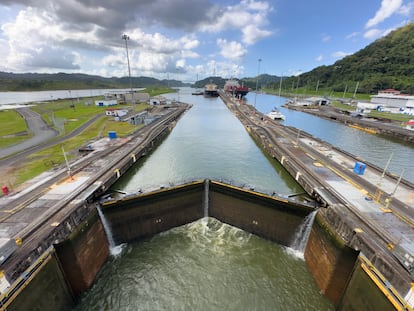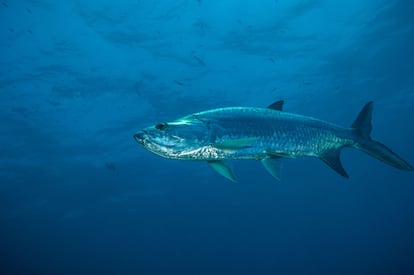Not just ships: The expansion of the Panama Canal also facilitates the transit of invasive fish
A new study reveals that the canal, inaugurated in 1914, is favoring a cross-invasion of species between the Atlantic and the Pacific

When we talk about the Panama Canal and invasions, some people may suspect political connotations related to certain current events. But fish, who care little for human affairs, only view the Central American canal as one more waterway in which to swim. The recent expansion of this feat of engineering that connects two oceans, completed in 2016, has facilitated the transit of ships, but also of fish. And now, a new study warns that the expanded canal is favoring a complete restructuring of the ecosystem and a cross-invasion of fish species between the Atlantic and the Pacific.
It is not surprising that artificial canals are conducive to biological invasions. This phenomenon has its own name: the Lessepsian migration took its name from the French diplomat Ferdinand de Lesseps, the architect of the Suez Canal that connects the Mediterranean to the Red Sea. Since the two seas were joined in 1869, scientists have documented the invasion of hundreds of species from the Red Sea into the Mediterranean. Due to the difference in level between the two, the water flows in this direction.
Furthermore, as Colombian marine ecologist Gustavo Castellanos-Galindo of the Leibniz Institute of Freshwater Ecology and Inland Fisheries (IGB) in Germany and the Smithsonian Tropical Research Institute (STRI) in Panama remarks, “many scientists suggest that the Mediterranean is becoming more tropical, and this could be one reason why Red Sea invaders are successful in the Mediterranean.”
A water bridge with a biological barrier
However, the Panama Canal, opened in 1914, might seem more resistant to invaders. Unlike the Suez Canal, which is just an artificial river at sea level, the Panama Canal is closed by locks on both sides, as ships must climb to cross it: in the way is Gatun Lake, a large artificial reservoir 26 meters above sea level that was created to reduce excavation work. The waters of Gatun are fresh and flow to both ends, thus acting as a biological barrier for marine species. For this reason, the Panama Canal has been described more as a water bridge than a river.
Yet, as early as 1975, a study found that six types of fish had managed to cross from the Atlantic to the Pacific, and three in the opposite direction; this does not include invertebrates or algae, which often travel as stowaways in ballast water or attached to the hulls of ships. In 2007, work began to expand the canal by adding a new waterway with greater capacity and enlarging existing ones to accommodate larger ships. Two years before its opening in 2016, a team of scientists from the Smithsonian Environmental Research Center in the U.S. predicted an increase in ship-mediated invasions in a computer simulation study.

Fish find their own way. According to Castellanos-Galindo, the new, larger locks facilitate their passage, and that is not the only factor: “For example, the new locks on the Pacific avoid Lake Miraflores, which is considered another barrier to fish migration.” The ecologist adds that fish on both sides of the Panamanian isthmus will probably find it easy to adapt to the opposite side, since the marine fauna of the Pacific and the Atlantic have only been separated for three million years and still include very similar species.
Marine fish take over the lake
Interestingly, before the canal expansion, Gatun Lake was dominated by freshwater fish that were not native, but invasive. The tucunaré or sergeant (Cichla ocellaris), native to the Amazon, Orinoco and other South American river basins, “escaped from an aquaculture pond and invaded the lake in the 1970s,” says Castellanos-Galindo. This fish was brought to Panama for sport fishing, while the invasive Nile tilapia was introduced as a food resource; “more recently we have found a few ornamental species probably released by people.”
To study the evolution of the lake’s fish communities, Castellanos-Galindo and his collaborators classified and quantified them from 2013 to 2016, and in 2019 they began to repeat this work to compare the situation before and after the canal expansion. The Covid pandemic opened a gap in their research, but by 2020 they had data to warn of a new wave of invasions when they detected the appearance of 11 new types of marine fish in the lake, increasing the number of these species from 18 to 29.
The new study, published in Current Biology, finds that marine fish are taking over what is increasingly less of a barrier, says senior study co-author Mark Torchin of STRI: “What we’re seeing now is the loss of some of that barrier and potentially increased permeability.” Before the expansion, introduced freshwater species accounted for 57 percent of the lake’s fish biomass, compared with 26 percent for marine fish and 17 percent for native freshwater fish. Now marine fish account for 76 percent, and freshwater fish account for 13 percent (introduced) and 11 percent (native). Of the marine species, 18 have entered from the Atlantic and five from the Pacific.
Tolerant to fresh water
The authors note that only a handful of cases of freshwater invasions by marine species have been documented over the past 200 years. But there is evidence that Gatun Lake is changing, Castellanos-Galindo says. Another recent study shows that the lake’s salinity has increased nearly fivefold since the canal was expanded.
The fish themselves are tough: “Most of the marine fish we’re catching in the lake are euryhaline [freshwater tolerant] and often associated with estuaries,” Torchin notes; “so they have the ability to tolerate those conditions.” These marine fish aren’t just passing through the lake, they’re here to stay. Castellanos-Galindo says: “They seem to be adapting well and staying in the freshwater system.”
An added factor is that among the marine species that now dominate the lake are large predators, fish up to half a meter long such as the malacho (Elops smithi) or the Common snook (Centropomus undecimalis), and others that exceed two meters such as the Atlantic Tarpón (Megalops atlanticus). In addition to the invasive potential between both oceans, these large carnivores are reshaping the ecosystem and its food webs, which will also affect the fishing communities that depend on it. The consequences of all this, warn the researchers in their study, are “difficult to predict.”
Sign up for our weekly newsletter to get more English-language news coverage from EL PAÍS USA Edition
Tu suscripción se está usando en otro dispositivo
¿Quieres añadir otro usuario a tu suscripción?
Si continúas leyendo en este dispositivo, no se podrá leer en el otro.
FlechaTu suscripción se está usando en otro dispositivo y solo puedes acceder a EL PAÍS desde un dispositivo a la vez.
Si quieres compartir tu cuenta, cambia tu suscripción a la modalidad Premium, así podrás añadir otro usuario. Cada uno accederá con su propia cuenta de email, lo que os permitirá personalizar vuestra experiencia en EL PAÍS.
¿Tienes una suscripción de empresa? Accede aquí para contratar más cuentas.
En el caso de no saber quién está usando tu cuenta, te recomendamos cambiar tu contraseña aquí.
Si decides continuar compartiendo tu cuenta, este mensaje se mostrará en tu dispositivo y en el de la otra persona que está usando tu cuenta de forma indefinida, afectando a tu experiencia de lectura. Puedes consultar aquí los términos y condiciones de la suscripción digital.
More information
Archived In
Últimas noticias
The story of the Málaga virus: The code that haunted Google’s cybersecurity center director for 30 years
The impact of Ecuador’s mega-prison: A polluted river, cleared forests and military checkpoints
Corinne Low: ‘I’m more concerned about the female happiness gap than the gender wage gap’
Trump traveled on Epstein’s plane ‘many more times’ than previously thought, according to new documents
Most viewed
- The low-cost creative revolution: How technology is making art accessible to everyone
- Christian Louboutin: ‘Young people don’t want to be like their parents. And if their parents wear sneakers, they’re going to look for something else’
- All the effects of gentrification in one corner of Mexico’s Colonia Roma
- Liset Menéndez de la Prida, neuroscientist: ‘It’s not normal to constantly seek pleasure; it’s important to be bored, to be calm’
- Christmas loses its festive spirit: ICE fears cast shadow over religious celebrations










































